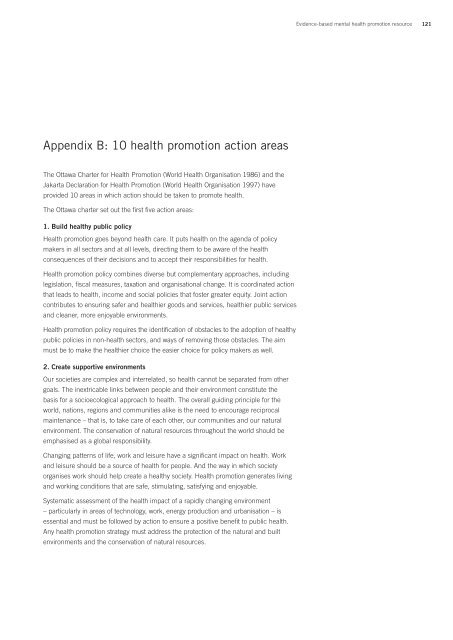Evidence-based mental health promotion resource - health.vic.gov.au
Evidence-based mental health promotion resource - health.vic.gov.au
Evidence-based mental health promotion resource - health.vic.gov.au
Create successful ePaper yourself
Turn your PDF publications into a flip-book with our unique Google optimized e-Paper software.
<strong>Evidence</strong>-<strong>based</strong> <strong>mental</strong> <strong>health</strong> <strong>promotion</strong> <strong>resource</strong>121Appendix B: 10 <strong>health</strong> <strong>promotion</strong> action areasThe Ottawa Charter for Health Promotion (World Health Organisation 1986) and theJakarta Declaration for Health Promotion (World Health Organisation 1997) haveprovided 10 areas in which action should be taken to promote <strong>health</strong>.The Ottawa charter set out the first five action areas:1. Build <strong>health</strong>y public policyHealth <strong>promotion</strong> goes beyond <strong>health</strong> care. It puts <strong>health</strong> on the agenda of policymakers in all sectors and at all levels, directing them to be aware of the <strong>health</strong>consequences of their decisions and to accept their responsibilities for <strong>health</strong>.Health <strong>promotion</strong> policy combines diverse but complementary approaches, includinglegislation, fiscal measures, taxation and organisational change. It is coordinated actionthat leads to <strong>health</strong>, income and social policies that foster greater equity. Joint actioncontributes to ensuring safer and <strong>health</strong>ier goods and ser<strong>vic</strong>es, <strong>health</strong>ier public ser<strong>vic</strong>esand cleaner, more enjoyable environments.Health <strong>promotion</strong> policy requires the identification of obstacles to the adoption of <strong>health</strong>ypublic policies in non-<strong>health</strong> sectors, and ways of removing those obstacles. The aimmust be to make the <strong>health</strong>ier choice the easier choice for policy makers as well.2. Create supportive environmentsOur societies are complex and interrelated, so <strong>health</strong> cannot be separated from othergoals. The inextricable links between people and their environment constitute thebasis for a socioecological approach to <strong>health</strong>. The overall guiding principle for theworld, nations, regions and communities alike is the need to encourage reciprocalmaintenance – that is, to take care of each other, our communities and our naturalenvironment. The conservation of natural <strong>resource</strong>s throughout the world should beemphasised as a global responsibility.Changing patterns of life, work and leisure have a significant impact on <strong>health</strong>. Workand leisure should be a source of <strong>health</strong> for people. And the way in which societyorganises work should help create a <strong>health</strong>y society. Health <strong>promotion</strong> generates livingand working conditions that are safe, stimulating, satisfying and enjoyable.Systematic assessment of the <strong>health</strong> impact of a rapidly changing environment– particularly in areas of technology, work, energy production and urbanisation – isessential and must be followed by action to ensure a positive benefit to public <strong>health</strong>.Any <strong>health</strong> <strong>promotion</strong> strategy must address the protection of the natural and builtenvironments and the conservation of natural <strong>resource</strong>s.



